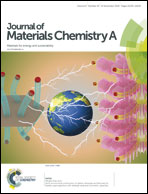The influence of the π-bridging unit of fused-ring acceptors on the performance of organic solar cells†
Abstract
We have designed and synthesized two fused-ring small molecular acceptors IDT-PDOT and IDT-EDOT, comprising 3,4-propylenedioxythiophene (PDOT) and 3,4-ethylenedioxythiophene (EDOT) bridging units, respectively. The only structural difference between these two acceptors is one methylene group at the π-bridging unit. However, such a tiny structural difference exerts a great influence on the optical, electrical and photovoltaic properties of the acceptors. The molar absorption coefficient of IDT-EDOT is more than four times higher than that of IDT-PDOT. The electron mobility of the IDT-EDOT based blend film is one order of magnitude higher than that of the IDT-PDOT based one. Consequently, a high power conversion efficiency (PCE) of 11.32% for IDT-EDOT based devices was obtained, whereas a PCE of only 2.18% was achieved for IDT-PDOT based ones. Our results have demonstrated that changing the π-bridging unit in fused ring acceptors is an effective strategy to adjust their photovoltaic performance.



 Please wait while we load your content...
Please wait while we load your content...